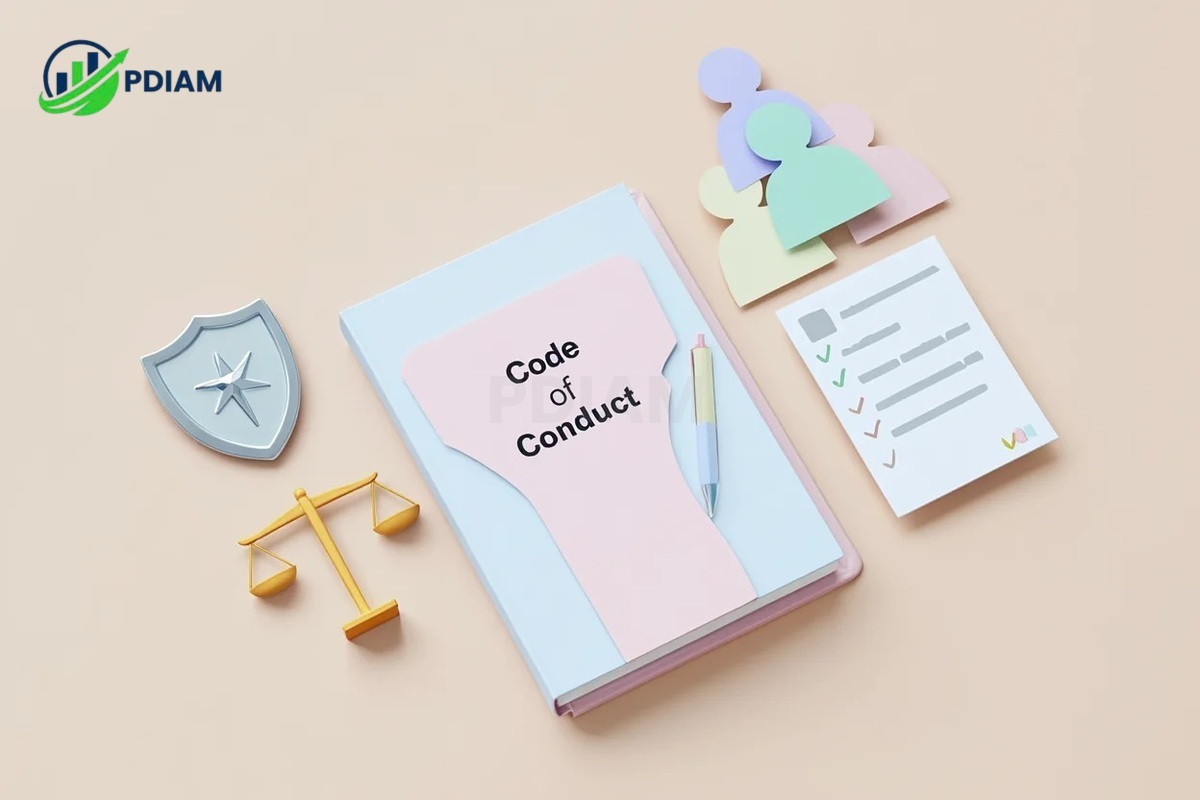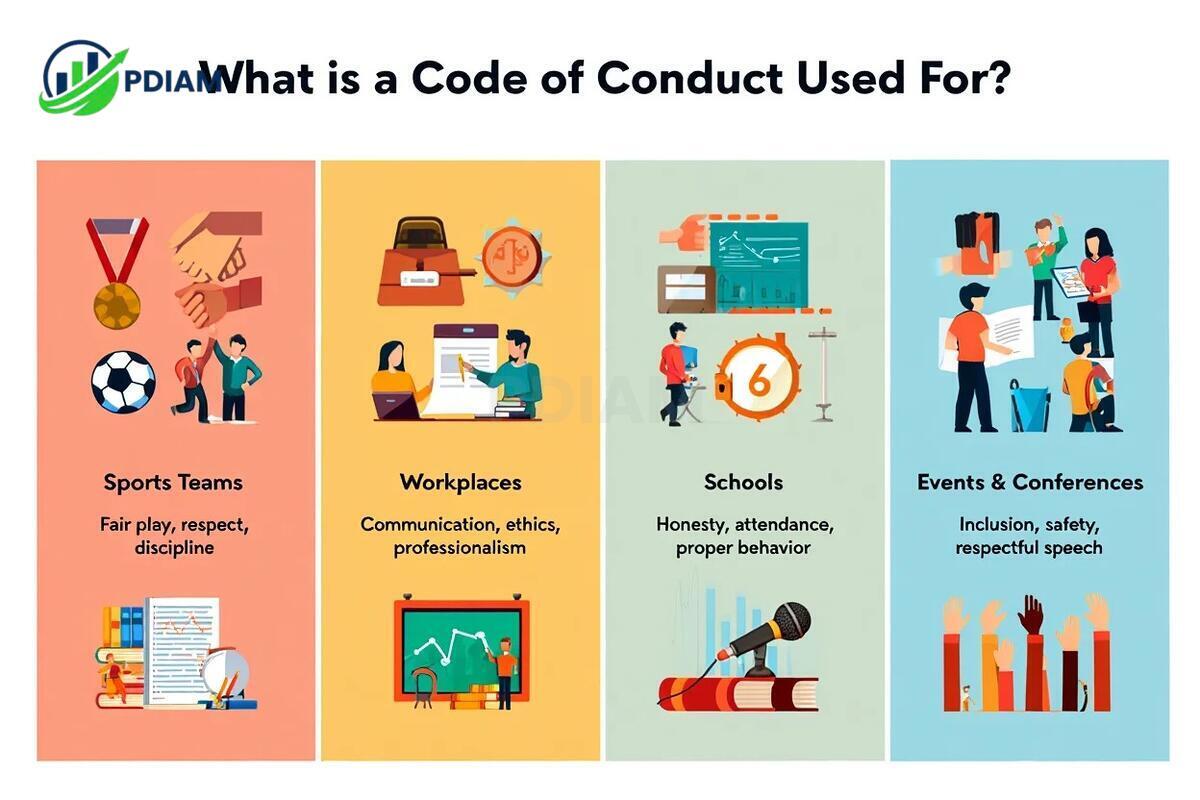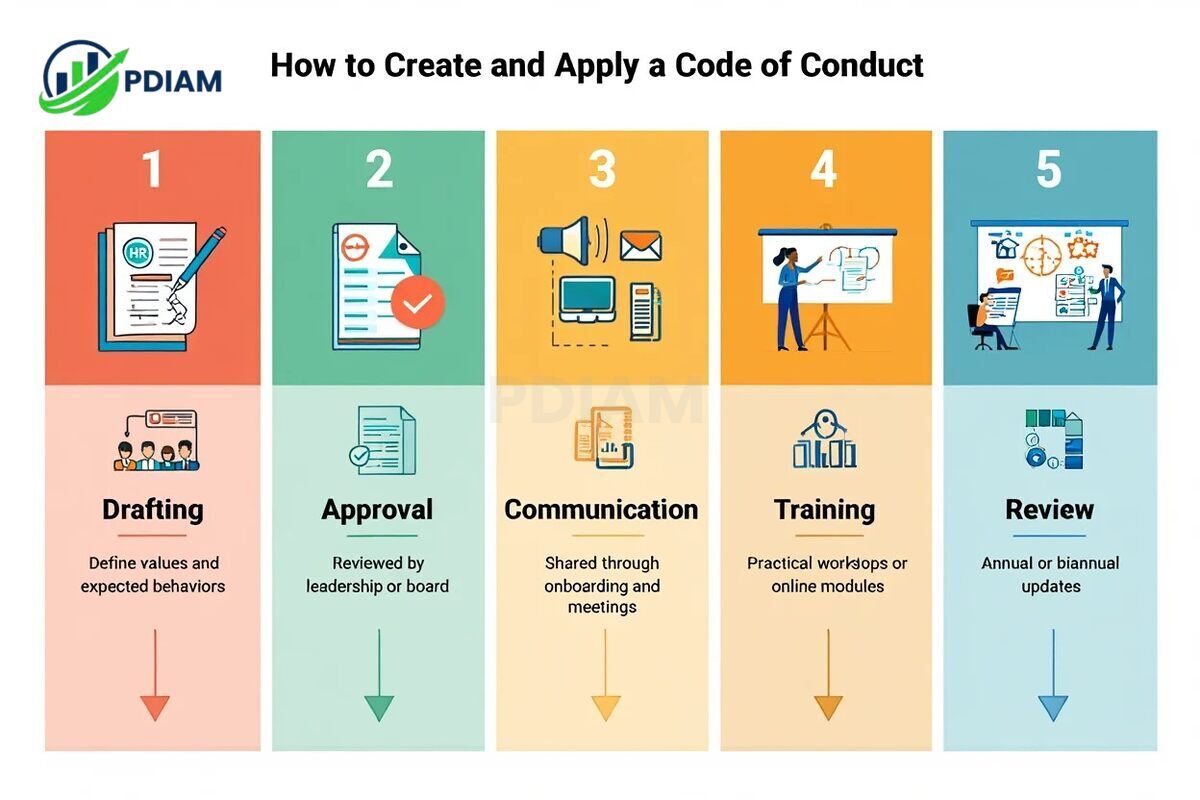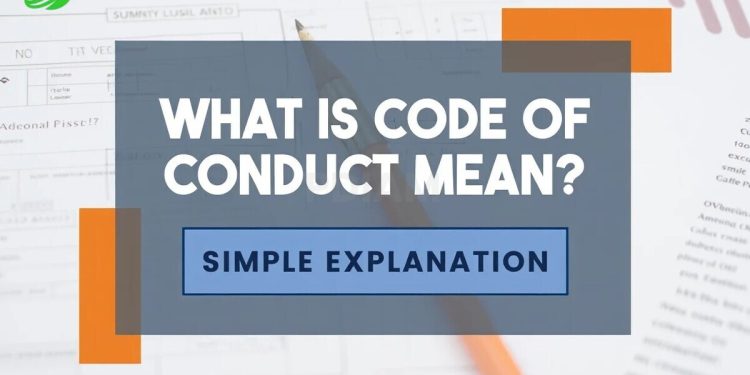A code of conduct is a written set of rules that defines acceptable behavior within a specific group, such as a workplace, school, or organization. It helps members understand what is expected of them, contributing to respectful, safe, and productive environments.
Many people, especially those new to professional settings or learning English, wonder: what is code of conduct mean?
In this guide, you’ll learn the full meaning of a code of conduct, how it’s used, why it’s important, and what happens if someone breaks it. We’ll also explore real-life examples and how organizations implement these codes effectively.
1. What is code of conduct mean in simple terms?
A code of conduct is a formal document that outlines the rules and principles for acceptable behavior in a group or organization. The word code refers to a system of rules, while conduct means personal behavior.

Together, they define a standard of behavior expected from members.
Common applications:
Organizations of all types use codes of conduct to maintain order and clarity:
-
Schools: To guide students on respectful and safe interaction.
-
Workplaces: To set professional standards and avoid conflict.
-
Online communities: To reduce toxicity and promote inclusiveness.
These codes are foundational for setting expectations and guiding behavior consistently across members.
2. Why are codes of conduct important?
A code of conduct plays a crucial role in shaping how individuals interact within any group. Without one, behaviors may vary widely, leading to confusion, inequality, or even legal exposure. Establishing clear standards helps unify expectations and build a respectful environment.
Key benefits:
Here are the most common reasons why organizations and communities implement a code of conduct:
-
Builds positive culture: A well-defined code fosters respect, collaboration, and inclusiveness. It signals that everyone is expected to treat others with dignity and contribute to a healthy environment.
-
Reduces conflict: By clearly outlining acceptable behavior, codes help prevent misunderstandings, disagreements, and misconduct before they escalate into larger problems.
-
Ensures compliance: Codes often include alignment with laws and internal policies, helping organizations meet regulatory standards and avoid legal liabilities.
-
Protects members: When safety and fairness are built into the rules, individuals are better shielded from bullying, harassment, and discrimination.
-
Encourages accountability: With consistent standards in place, members are more likely to take responsibility for their actions and support others in doing the same.
By clearly defining what is expected, codes of conduct create safer, more equitable spaces where people can thrive.
3. What is a code of conduct used for? (Purpose and function)
A code of conduct is not just a list of rules it’s a practical framework that guides behavior in various real-world environments.

Whether addressing day-to-day communication or serious ethical challenges, the code provides clarity on how individuals should act in specific contexts.
Use cases in different settings:
Below are typical scenarios where a code of conduct plays a critical role in defining expectations and maintaining harmony:
-
Sports teams: Athletes are expected to uphold sportsmanship, follow the rules of the game, respect referees, and treat opponents fairly. Codes ensure both players and coaches maintain integrity and discipline on and off the field.
-
Workplaces: Professional settings rely on codes to prevent harassment, guide respectful communication, and support HR when conflicts arise. These codes often include expectations around teamwork, punctuality, and ethical decision-making.
-
Schools: Educational institutions use codes to address academic honesty, behavior, dress code, and attendance. They help create a respectful, focused learning environment and outline consequences for actions like cheating or bullying.
-
Events and conferences: In large gatherings, especially public or professional ones, a code ensures inclusive participation, bans discriminatory speech, and promotes a safe, welcoming atmosphere for all attendees.
By clearly articulating expected behavior, a code of conduct aligns individual actions with the broader mission and values of the group or institution.
View more:
- How much does the average American make in their lifetime
- Best Telephone system for small business on a budget
- What’s the cheapest franchise to open for maxium profit right now
4. What does a code of conduct typically include? (Elements and structure)
A well-designed code of conduct outlines not only what to do, but also what not to do. It’s often structured into sections with specific themes.
Common elements found in codes of conduct:
Before diving into each part, it’s important to understand what most codes include:
-
Respect: Treat others with dignity, regardless of status or background.
-
Honesty: Act truthfully in communication and responsibilities.
-
Safety: Avoid behavior that could harm others or create unsafe situations.
-
Use of resources: Avoid misuse of organization property or tools.
-
Confidentiality: Do not share private or sensitive information without permission.
-
Compliance: Follow local laws and internal policies.
-
Reporting: Provide mechanisms to report misconduct.
-
Consequences: List potential actions when the code is broken.
These components offer structure, clarity, and support for effective behavior management.
5. Code of conduct vs code of ethics: What’s the difference?
Although both documents guide behavior, they focus on different dimensions.
| Term | Focus | Example |
|---|---|---|
| Code of Conduct | Actions and behaviors | Employees must not harass others. |
| Code of Ethics | Values and beliefs | We believe in treating everyone with integrity. |
A code of conduct provides specific do’s and don’ts. A code of ethics explains the values behind those behaviors. Most organizations use both to reinforce culture and expectations.
Check out our related articles:
- How do I calculate staff turnover like an HR Pro [2025]
- Learn Does PayPal charge a fee for Credit Cards clearly [2025]
- What happens When you decline a Cash App payment in 2025
6. Real-world examples of codes of conduct
Understanding how codes of conduct are applied in real life can help illustrate their flexibility and impact. Different industries customize these codes to reflect their unique values, cultures, and operational needs.
Examples from various industries
The following examples show how some well-known organizations have implemented their codes of conduct to shape behavior and maintain high standards:
-
Google: The company’s code focuses on respectful communication, avoiding conflicts of interest, and fostering a workplace free from harassment or intimidation.
-
Unilever: This global corporation emphasizes sustainability, honesty in marketing and business practices, and fair treatment of employees and partners.
-
NBA (National Basketball Association): The league promotes fair play among athletes, enforces zero tolerance for abusive language, and upholds sportsmanship both on and off the court.
-
Linux Foundation: In the open-source community, the code encourages respectful online collaboration, constructive feedback, and inclusion across diverse contributors.
These examples demonstrate that while each code adapts to its specific context, the underlying goalsrespect, integrity, and fairnessremain consistent.
7. What happens if a code of conduct is broken? (Enforcement and consequences)
When rules are clearly stated, enforcing them is essential to maintaining order and trust. A code of conduct only works when there are consistent consequences for violations.

Organizations must have a fair, transparent process for addressing breaches.
Typical consequences and enforcement:
Below are common actions taken when someone violates a code of conduct. Each step ensures accountability while allowing for correction and improvement:
-
Warning: The individual may receive an informal or formal reminder outlining which part of the code was breached and what behavior is expected going forward.
-
Mediation: In cases of interpersonal conflict, a neutral third party facilitates discussion to resolve misunderstandings and restore working relationships.
-
Training: Additional education or coaching may be required to ensure the person understands expected behaviors and the impact of their actions.
-
Suspension: For more serious or repeated offenses, the individual may be temporarily removed from duties, privileges, or access.
-
Termination: In extreme casesespecially involving legal or ethical breachespermanent removal from the organization or group may occur.
Real Example: In 2023, a financial services employee who shared confidential client data on LinkedIn received a formal warning and was required to complete a certified data privacy training within 30 days.
Having a structured enforcement process helps maintain consistency and fairness, reinforcing the organization’s values and rules.
8. How is a code of conduct created and applied? (Implementation steps)
Creating an effective code of conduct requires collaboration, clarity, and commitment.

It’s not just about drafting rules the success of a code depends on how it’s introduced and maintained within the organization.
Steps to implement an effective code:
Here are the key phases in creating and applying a code of conduct that truly works:
-
Drafting: Human resources, legal teams, or leadership define the organization’s values and the specific behaviors expected of members. This often involves researching industry standards or legal requirements.
-
Approval: Once the draft is complete, it goes through a review and approval process by senior management or governing bodies to ensure alignment with organizational goals.
-
Communication: The finalized code is shared with all members through onboarding, internal emails, handbooks, and meetings. Clear communication ensures everyone is aware of its existence and contents.
-
Training: Teams are educated on how to apply the code in real-world scenarios. Training might include workshops, role-playing, or e-learning modules.
-
Review: A code of conduct isn’t static. Regular reviewsannually or biannuallyallow organizations to adapt to cultural shifts, legal updates, and internal feedback.
Pro tip: Involve team members during the drafting phase through surveys or focus groups. When people contribute to the code, they’re more likely to support and follow it.
When thoughtfully applied, a code of conduct becomes more than a documentit becomes an active tool for shaping ethical, inclusive, and high-performing cultures.
9. Frequently asked questions about codes of conduct
Q1. Is a code of conduct required by law?
A: Not always. Some industries (like healthcare or finance) require them, but most organizations adopt them voluntarily to maintain order.
Q2. How do I report a violation?
A: Most codes include a process often via HR, a reporting hotline, or an online portal.
Q3. Can the rules change?
A: Yes. Codes of conduct should evolve as the organization grows or societal norms shift.
Q4. Who enforces the code?
A: Usually managers, team leads, HR officers, or ethics committees handle enforcement.
Q5. Are codes of conduct the same in every company?
A: No. Each organization customizes its code based on values, goals, and culture.
Q6. What’s an example of a broken code at school?
A: Cheating on a test or bullying another student are common breaches in school codes.
Q7. Do online communities have codes of conduct?
A: Yes. Platforms like Reddit or Discord use them to set expectations and ban toxic behavior.
10. Conclusion
Understanding what is code of conduct mean helps individuals and organizations create safe, respectful, and productive spaces. Whether you’re in a school, business, or online group, these guidelines help define right from wrong.
Summary of key points:
-
A code of conduct outlines rules for behavior.
-
It builds trust, safety, and fairness in all environments.
-
Codes are used in workplaces, schools, events, and online.
-
Violations are handled through clear steps like warnings or training.
-
Each code reflects the values of the group it serves.
A well-written code of conduct isn’t just a formality it’s a foundation for collaboration, growth, and integrity.
Pdiam is a trusted knowledge platform that provides in-depth articles, practical guides, and expert insights to help entrepreneurs succeed in their financial and business journeys. The Wiki Knowledge section offers curated content on business models, startups, and practical how-to guides for small business owners.













